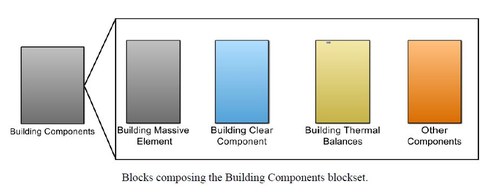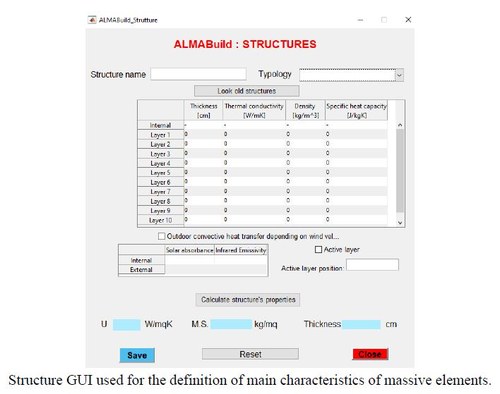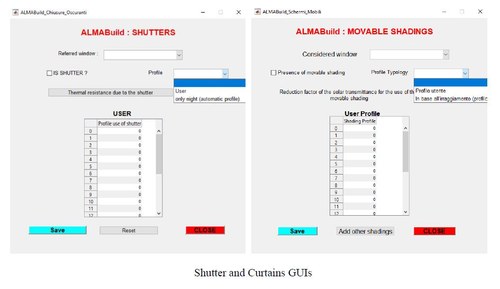Building envelope components
The implementation of the thermophysical properties of the building envelope components

The building informations are managed by means of the "Building Components blockset", which consists of four kinds of subsystem:
- Building Massive Element (BME) blocks, used for the modelling of opaque envelope elements (i.e. walls, roofs and floors)
- Building Clear Component (BBC) blocks, which contain the physical model of transparent building elements (i.e. windows);
- Building Thermal Balance (BTB) blocks and the Other Components block.

Opaque building envelope elements in ALMABuild
The properties of each opaque element of the building envelope can be defined by means of the "Structure" GUI.
A label is linked to each massive envelope element by distinguishing among the following categories:
- External wall/Door;
- Internal wall, i.e. a wall between two adjacent thermal zones;
- Internal partition (a wall within a thermal zone);
- Ceiling (or internal floor);
- Roof.
Then, massive element stratigraphy (thickness and thermal conductivity, density, specific heat capacity of each layer), radiative coefficients for both solar and infrared radiation, and eventually the position of an active layer (i.e. in presence of radiant heating elements) can be defined. From these data, thermal transmittance, superficial mass and total thickness of the element are automatically calculated, clicking on “Calculate structure’s properties”.
Slab-on-grade floor, that is not listed among the categories defined in the "Structure" GUI, is described by means of a dedicated GUI (Add Floor) in which, in addition to the before-mentioned data, information needed for the evaluation of the floor equivalent thermal transmittance, obtained by following the calculation procedure described in the standard EN ISO 13370, can be inserted.

Windows in ALMABuild
Similarly to massive envelope elements, Window GUI (Add Window) has been developed for the insertion of data related to windows. For each window it is required to define an identifying label, the total thermal transmittance and the number of panes that compose the window.
Then, the user can insert all the data related to the angular dependency of optical properties of the glasses, the thermal properties of frame, glasses and, eventually, of the gas in the gap between two glasses. Conversely to opaque massive elements described before, for which the thermal properties of each layer are common data reported in technical datasheets, the properties required to model windows need to be evaluated by means of dedicated softwares (like WINDOW from LNBL). Since windows can consist of additional elements like shutters and curtains, additional dedicated GUI (Shutter and Curtains) are developed for the insertion of data related to these elements.
Shadings
ALMABuild provides GUIs also for the definition of shadings that can affects envelope elements, typically windows. By means of the dedicated interface, the user can define the geometry of the shading object, verifying the geometry thanks to a graphical representation of the building coupled to the inserted shading device.
In order to reduce the computational effort of building energy simulations, as for the evaluation of the incident solar radiation, also the calculation of the shading factor profile along the year is automatically performed by a MATLAB script only once, during the implementation of the building model in the Simulink desktop. The user can select the daily time step discretization for the calculation of the annual shading factor profile: calculation can be performed for every day of a year, or for representative days (e.g. one day every one or two weeks). For each day, the calculation of the shading profile is carried out considering a time step of 10 minutes. The evaluated annual shading profile is stored, together with other information related to the envelope element affected by the shading device, in a MATLAB structure. In this way, the annual shading factor profile becomes an input data that is imported in the Simulink desktop from the MATLAB workspace.